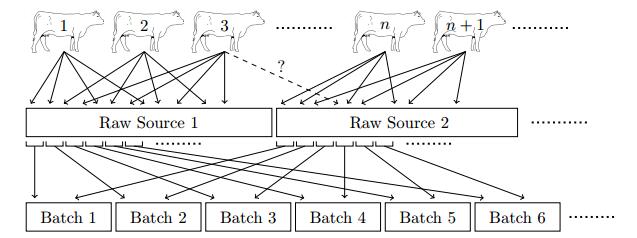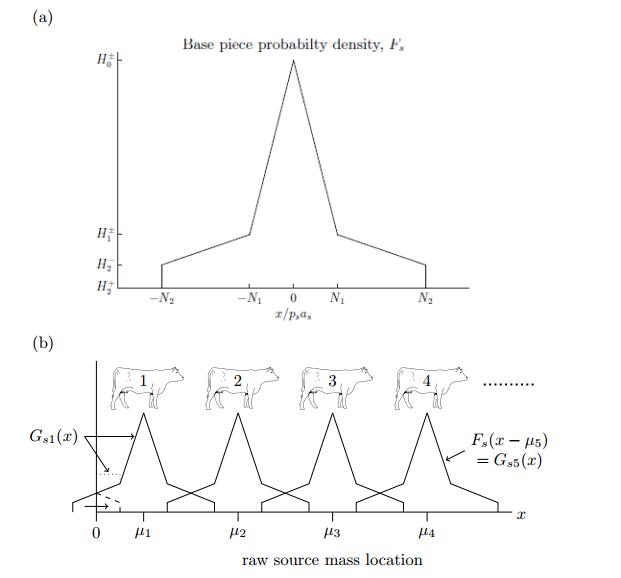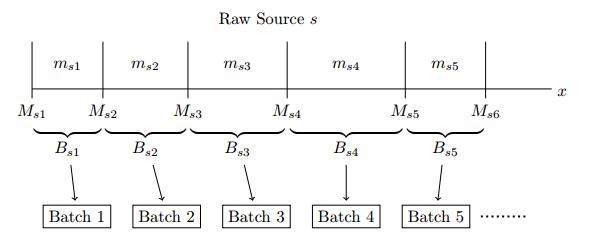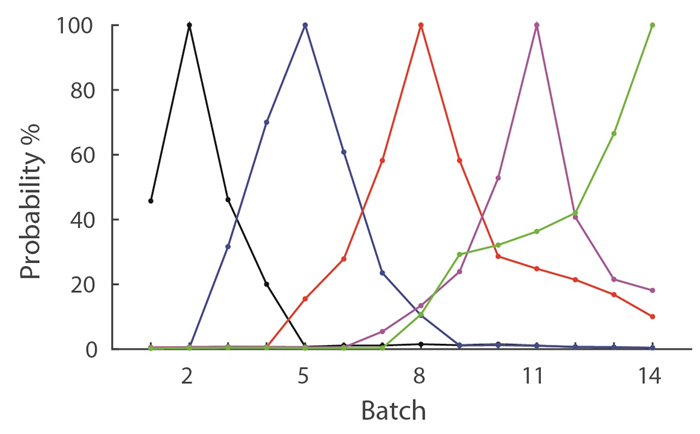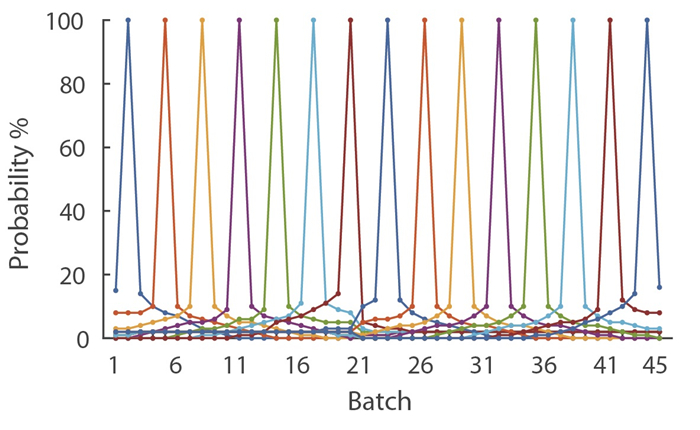1.
Introduction
For thousands of years throughout history, mathematicians, philosophers, and scientists have studied the surface idea. In the process, differential geometry's advancements have substantially strengthened the theory of surfaces. The pioneers in this field of study were Gauss, Riemann, and Poincare, but Monge also made some important contributions to the study of surfaces. Surfaces are represented as graphs of functions of two variables according to Monge's methodology.
A surface that can be created by moving a straight line along a spatial curve is a ruled surface [1,2]. Since they have relatively simple features and enable us to analyze intricate surfaces, ruled surfaces are recommended for study. Among the main topics of research on ruled surfaces are their classification, features attributed to the base curve, geodesics, shape operators of surfaces, and the study of developable and non-developable ruled surfaces.
Since the Lorentzian metric is not a positive definite metric, the differential geometry of ruled surfaces in the Minkowski 3-space E31 is far more complex than in the Euclidean event. In contrast to the distance function in Euclidean space, which may only be positive, the distance function ⟨,⟩ can be positive, negative, or zero.
Similar properties may be seen in the Euclidean space when ruled surfaces in the Minkowski space are surveyed, but the structure of the Minkowski space leads to some fascinating contrasts. Ruled surfaces in Minkowski space have more complicated geometry than those in Euclidean space, since their characterization is dependent on both the direction and the base curve. Regulated surfaces can be categorized as developable or non-developable, as is currently understood [3,4,5,6,7,8,9,10,11,12,13,14,15,16].
A Darboux frame is a natural moving frame constructed on a surface; it is the analog of the Frenet-Serret frame as applied to surface geometry. A Darboux frame exists at any non-umbilic point of a surface embedded in the Euclidean space [17,18].
The aim of this study is to develop a brand-new frame called the rotation-minimizing Darboux frame (RMDF), which travels along a spacelike curve that entirely encircles a timelike surface in the coordinate system E31. We also demonstrate how to use RMDF to create imbricate-ruled surfaces in Minkowski 3-space using the vectors of the Frenet frame of non-null space curves. Next, depending on the curvatures of the base curve, requirements are simultaneously given for each imbricate-ruled surface to be minimal or developable. Asymptotic, geodesic, and curvature lines are examples of parametric curves that are characterized by these requirements. An example concerning imbricate-ruled surfaces are given at the conclusion of the inquiry.
2.
Preliminaries
The definition of the Lorentzian product in Minkowski three-dimensional space E31 is
where (s1,s2,s3) is E31's coordinate system. The characteristics of an arbitrary vector ζ∈E31 are as follows: spacelike if L(ζ,ζ)>0 or ζ=0, timelike if L(ζ,ζ)<0, and null if L(ζ,ζ)=0 and ζ≠0. Similarly, a curve μ=μ(s) can be spacelike, timelike, or null if its μ′(s) is spacelike, timelike, or null. The vector product of vectors u=(u1,u2,u3) and v=(v1,v2,v3) in E31 is defined by [18,19]
Consider a timelike embedding Θ:U→E31 from open subset U∈E2 represented by a regular timelike surface Θ(s,u). The Θ's tangent vectors are
The unit normal vector to Θ given as
The coefficient of first and second fundamental forms given as:
The Gaussian and mean curvatures are defined as:
Let ϕ:I⊆R→Θ is a regular spacelike curve with timelike binormal on Θ. Denoted {T,N,B} be the moving Frenet frame of ϕ, then {T,N,B} has the following properties: [1,18,19,20]:
where (′=dds), L(T,T)=L(N,N)=−L(B,B)=1, L(T,N)=L(N,B)=L(T,B)=0 and κ(s), and τ(s) are the curvature functions of ϕ. For the unit vector P defined by P=N×T, the Darboux frame {T,N,P} associated with ϕ(s) in E31 satisfying the equations [1,18]:
where L(T,T)=L(N,N)=−L(P,P)=1 and L(T,N)=L(T,P)=L(N,P)=0. Here, the normal curvature κn(s), the geodesic curvature κg(s), and the geodesic curve τg(s) of ϕ can be obtained as follows:
3.
Rotation-minimizing Darboux frame
It is well known that the Frenet frame along a space curve on a surface is the source of the Bishop frame. In this section, by the same way we develop a brand-new alternative of the Darboux frame known as the (RMDF) on a surface in Minkowski 3-space along a space curve. Next, we get the intrinsic equations resulting from the RMDF for a generalized relaxed elastic line situated on an orientated surface. Let ϕ=ϕ(s) be a regular spacelike curve moving at unit speed that has a timelike binormal vector entirely affixed to a timelike surface Ψ in E31 through a Darboux frame (2.5). Let's use the notation {T,V1,V2} to denote an RMDF. A brief calculation demonstrates that
Differentiate (3.1) with respect to s and using (2.5), we have
The equalities (3.1), on the other hand, are obtained by combining
Then, we get
The derivative with respect to s produces the frame similarly to the previous frames:
Assume τg(s)=−θ′(s), the RMDF's variation formula is given in the accompanying statement, which reads as follows:
Theorem 3.1. Let ϕ=ϕ(s) be a spacelike curve lying fully on a timelike surface Ψ space E31 via to Darboux frame (2.5). Then, the RMDF {T,V1,V2} is given by
where ξ1 and ξ2 are RMDF's curvatures that are obtained by the relation:
The angle θ(s) between N and V1 is given by
also, we have the relation
Corollary 3.1. Let ϕ=ϕ(s) be a spacelike curve lying fully on a timelike surface Ψ in space E31 via to RMDF (3.2). If ϕ(s) is an asymptotic curve, then ξ1 and ξ2 satisfy
Corollary 3.2. Let ϕ=ϕ(s) be a spacelike curve lying fully on a timelike surface Ψ in space E31 via to RMDF (3.2). If RMDF's curvatures are constants on a geodesic or asymptotic, then τg(s)=−θ′(s)=0 and ϕ(s) will be a principal curve.
4.
Characterizations of imbricate-ruled surfaces
This section examines specific imbricate-ruled surfaces as an application of the RMDF in the Minkowski 3-space E31 for a given timelike surface and a spacelike curve completely resting on it. We anticipate that researchers with competence in mathematical modeling will find our findings to be valuable.
Definition 4.1. For a regular spacelike curve ϕ=ϕ(s) with timelike binormal vector and lying fully on a timelike surface Ψ in E31. The TV1-imbricate-ruled surfaces via RMDF (3.2) of ϕ(s) are defined by
Theorem 4.1. Let ϕ=ϕ(s) be a unit speed spacelike curve lying fully on a timelike surface Ψ in E31 via to RMDF (3.2). Then TV1-imbricate-ruled surfaces (4.1) are developable surfaces.
Proof. Using (3.2), we obtained the first and second partial derivatives in the first equation (4.1) with regard to s and υ, we get
The normal vector field of the surface ΦTV1(s,υ) may be ascertained by taking the cross-product of the partial derivatives of the surface given by Eq (4.2)
With the aforementioned equation, we can obtain the first and second fundamental forms of ΦTV1's component parts as follows:
The Gaussian curvature KTV1 and the mean curvature HTV1 are determined using the data mentioned above:
However, by applying the RMDF (3.2) and differentiating the second equation in (4.1) with regard to s and υ to get the first and second partial derivatives, we obtain
The normal vector field of the surface ΦV1T(s,υ) is determined as follows:
The ΦV1T's component of the first and second fundamental forms are obtained as:
So, the Gaussian curvature and the mean curvature are given by
Corollary 4.1. Let ϕ=ϕ(s) be a unit speed spacelike curve lying fully on a timelike surface Ψ in E31 via to RMDF (3.2). Then the s-parameter curves of TV1-imbricate-ruled surfaces (4.1) are
ⅰ. not geodesic,
ⅱ. asymptotic curves iff θ(s)=tanh−1(κgκn) or θ(s)=tanh−1(κnκg).
Proof. Let ΦTV1(s,υ) defined by (4.1) due to RMDF (3.2) in E31 be imbricate-ruled surface. Since
and
Since (ΦTV1)ss×UTV1≠0 and \left(\Phi^{V_1}_T\right)_{ss}\times\mathbb{U}^{V_1}_T\neq0 , then s -parameter curves of TV_1 -imbricate-ruled surfaces are not geodesic. Now
and
From here, if \xi_1 = 0 and \xi_2\neq0 or \xi_1\neq0 and \xi_2 = 0 , then \Big\langle\left(\Phi^T_{V_1}\right)_{ss}, \mathbb{U}^T_{V_1}\Big\rangle = 0 and \Big\langle\left(\Phi^{V_1}_T\right)_{ss}, \mathbb{U}^{V_1}_T\Big\rangle = 0 . So the s -parameter curves of TV_1 -imbricate-ruled surfaces are asymptotic curves iff \theta(s) = \tanh^{-1}{\Big(\dfrac{ {\kappa}_g}{ {\kappa}_n}\Big)} or \theta(s) = \tanh^{-1}{\Big(\dfrac{ {\kappa}_n}{ {\kappa}_g}\Big)} .
Corollary 4.2. Let \phi = \phi(s) be a unit speed spacelike curve lying fully on a timelike surface \Psi in \mathrm{E}_1^3 via to RMDF (3.2). Then the \upsilon -parameter curves of TV_1 -imbricate-ruled surfaces (4.1) are
ⅰ. geodesic,
ⅱ. asymptotic curves.
Proof. Let \Phi^T_{V_1}(s, \upsilon) defined by (4.1) due to RMDF (3.2) in \mathrm{E}_1^3 be an imbricate-ruled surface. Since \left(\Phi^T_{V_1}\right)_{ \upsilon}\times\mathbb{U}^T_{V_1} = 0 and \left(\Phi^{V_1}_T\right)_{ \upsilon \upsilon}\times\mathbb{U}^{V_1}_T = 0 , then the \upsilon -parameter curves of TV_1 -imbricate-ruled surfaces are geodesic. Also, since \Big\langle\left(\Phi^T_{V_1}\right)_{ \upsilon \upsilon}, \mathbb{U}^T_{V_1}\Big\rangle = 0 and \Big\langle\left(\Phi^{V_1}_T\right)_{ \upsilon \upsilon}, \mathbb{U}^{V_1}_T\Big\rangle = 0 , then the \upsilon -parameter curves of TV_1 -imbricate-ruled surfaces are asymptotic curves.
Corollary 4.3. Let \phi = \phi(s) be a unit speed spacelike curve lying fully on a timelike surface \Psi in \mathrm{E}_1^3 via to RMDF (3.2). Then the s and \upsilon -parameter curves of TV_1 -imbricate-ruled surfaces (4.1) are principal curves if and only if \xi_1 = 0 .
Proof. Let \Phi^T_{V_1}(s, \upsilon) defined by (4.1) due to RMDF (3.2) in \mathrm{E}_1^3 be an imbricate-ruled surface. From equations (4.4), (4.5), (4.9) and (4.10), we have
for \xi_1 = 0 , thus, the proof is completed.
Definition 4.2. For a regular spacelike curve \phi = \phi(s) with timelike binormal vector and lying fully on a timelike surface \Psi in \mathrm{E}_1^3 . The TV_2 -imbricate-ruled surfaces via RMDF (3.2) of \phi(s) are defined by
Theorem 4.2. Let \phi = \phi(s) be a unit speed spacelike curve lying fully on a timelike surface \Psi in \mathrm{E}_1^3 via to RMDF (3.2). Then TV_2 -imbricate-ruled surfaces (4.12) are developable and minimal surfaces iff \theta(s) = \tanh^{-1}{\Big(\dfrac{ {\kappa}_g}{ {\kappa}_n}\Big)} or \theta(s) = \tanh^{-1}{\Big(\dfrac{ {\kappa}_n}{ {\kappa}_g}\Big)} .
Proof. Using (3.2) and differentiating the first Eq (4.12) with regard to s and \upsilon , we get
The normal vector field of the surface \Phi^T_{V_2}(s, \upsilon) is obtained as:
With the aforementioned equation, we can obtain the first and second fundamental forms of \Phi^T_{V_2} 's component parts as follows:
The Gaussian curvature K^T_{V_2} and the mean curvature H^T_{V_2} are determined using the data mentioned above:
However, by applying the RMDF (3.2) and differentiating the second equation in (4.12) with regard to s and \upsilon , respectively, we obtain
The normal vector field of the surface \Phi^{V_2}_T(s, \upsilon) is obtained as:
The \Phi^{V_2}_T 's component of the first and second fundamental forms are obtained as:
So, the Gaussian curvature and the mean curvature are given by
For \xi_1 = 0 and \xi_2\neq0 or \xi_1\neq0 and \xi_2 = 0 the proof is completed.
As a consequence of Theorem 4.2, we obtain the following results:
Corollary 4.4. Let \phi = \phi(s) be a unit speed spacelike curve lying fully on a timelike surface \Psi in \mathrm{E}_1^3 via to RMDF (3.2). Then the s -parameter curves of TV_2 -imbricate-ruled surfaces (4.12) are not geodesic and asymptotic curves.
Corollary 4.5. Let \phi = \phi(s) be a unit speed spacelike curve lying fully on a timelike surface \Psi in \mathrm{E}_1^3 via to RMDF (3.2). Then the \upsilon -parameter curves of TV_2 -imbricate-ruled surfaces (4.12) are geodesic and asymptotic curves.
Corollary 4.6. Let \phi = \phi(s) be a unit speed spacelike curve lying fully on a timelike surface \Psi in \mathrm{E}_1^3 via to RMDF (3.2). Then the s and \upsilon -parameter curves of TV_2 -imbricate-ruled surfaces (4.12) are principal cuves iff \theta(s) = \tanh^{-1}{\Big(\dfrac{ {\kappa}_n}{ {\kappa}_g}\Big)} or \theta(s) = \tanh^{-1}{\Big(\dfrac{ {\kappa}_g}{ {\kappa}_n}\Big)} .
Remark 4.1. The proof of Corollaries 4.4–4.6 is similar to the proof of Corollaries 4.1–4.3.
Definition 4.3. For a regular spacelike curve \phi = \phi(s) with timelike binormal vector and lying fully on a timelike surface \Psi in \mathrm{E}_1^3 . The V_1V_2 -imbricate-ruled surfaces via RMDF (3.2) of \phi(s) are defined by
Theorem 4.3. Let \phi = \phi(s) be a unit speed spacelike curve lying fully on a timelike surface \Psi in \mathrm{E}_1^3 via to RMDF (3.2). Then V_1V_2 -imbricate-ruled surfaces (4.23) are developable surfaces.
Proof. Using (3.2) and differentiating the first Eq (4.23) with regard to s and \upsilon , we get
The normal vector field of the surface \Phi^{V_1}_{V_2}(s, \upsilon) is obtained as:
With the aforementioned equation, we can obtain the first and second fundamental forms of \Phi^{V_1}_{V_2} 's component parts as follows:
The Gaussian curvature K^{V_1}_{V_2} and the mean curvature H^{V_1}_{V_2} are determined using the data mentioned above:
However, by applying the RMDF (3.2) and differentiating the second equation in (4.23) with regard to s and \upsilon , respectively, we obtain
The normal vector field of the surface \Phi^{V_2}_{V_1}(s, \upsilon) is obtained as:
The \Phi^{V_2}_{V_1} 's component of the first and second fundamental forms are obtained as:
So, the Gaussian curvature and the mean curvature are given by
Corollary 4.7. Let \phi = \phi(s) be a unit speed spacelike curve lying fully on a timelike surface \Psi in \mathrm{E}_1^3 via to RMDF (3.2). Then, {V_1}V_2 -imbricate-ruled surfaces (4.23) have constant mean curvature iff
ⅰ. \dfrac{\xi_1}{\xi_2} = \dfrac{2 \upsilon c}{2c-1} for some non-zero constant c\neq\dfrac{1}{2} ,
ⅱ. \xi_2- \upsilon\xi_1 = c for some non-zero constant c .
Corollary 4.8. Let \phi = \phi(s) be a unit speed spacelike curve lying fully on a timelike surface \Psi in \mathrm{E}_1^3 via to RMDF (3.2). Then \upsilon -parameter curves of {V_1}V_2 -imbricate-ruled surfaces (4.23) are geodesic curves iff one of the following conditions holds
ⅰ. \theta(s) = \tanh^{-1}{\Big(\dfrac{ {\kappa}_n}{ {\kappa}_g}\Big)} and \xi_1 is non-zero constant,
ⅱ. \theta(s) = \tanh^{-1}{\Big(\dfrac{ {\kappa}_g}{ {\kappa}_n}\Big)} and \xi_2 is non-zero constant.
Corollary 4.9. Let \phi = \phi(s) be a unit speed spacelike curve lying fully on a timelike surface \Psi in \mathrm{E}_1^3 via to RMDF (3.2). Then \upsilon -parameter curves of {V_1}V_2 -imbricate-ruled surfaces (4.23) are asymptotic curves iff one of the following conditions holds
ⅰ. \theta(s) = \tanh^{-1}{\Big(\dfrac{ {\kappa}_g}{ {\kappa}_n}\Big)} and \xi_2 = \upsilon\xi_1 ,
ⅱ. \theta(s) = \tanh^{-1}{\Big(\dfrac{ {\kappa}_n}{ {\kappa}_g}\Big)} and \xi_1 = \upsilon\xi_2 .
Corollary 4.10. Let \phi = \phi(s) be a unit speed spacelike curve lying fully on a timelike surface \Psi in \mathrm{E}_1^3 via to RMDF (3.2). Then the \upsilon -parameter curves of {V_1}V_2 -imbricate-ruled surfaces (4.23) are geodesic and asymptotic curves.
Corollary 4.11. Let \phi = \phi(s) be a unit speed spacelike curve lying fully on a timelike surface \Psi in \mathrm{E}_1^3 via to RMDF (3.2). Then the s and \upsilon -parameter curves of {V_1}V_2 -imbricate-ruled surfaces (4.23) are principal cuves.
5.
Example
Take into account that a spacelike curve with timelike binomal vector in \mathrm{E}_1^3 parameterized \phi(s) = \left(\cosh{s}, \sinh{s}, 0\right) lying fully on a timelike ruled surface is given by the equation (see Figure 1)
So, the Darboux frame of \varphi can be written as:
Then, we have
Then \theta(s) = \theta_0 is a constant. Moreover,
Consequently, the parametric of imbricate-ruled surfaces can be given as (see Figures 2–4):
6.
Conclusions
Recently, numerous researchers have used the Bishop frame and Darboux frame to investigate curves and surfaces, just as they did with the Frenet frame. Recently, the idea of a B-Darboux frame was demonstrated; further investigation may be conducted in the future. The RMDF that we develop in this paper travels along a spacelike curve that fully encircles a timelike surface in \mathrm{E}_1^3 . We also demonstrate how to use RMDF on imbricate-ruled surfaces.
Use of AI tools declaration
The authors declare they have not used Artificial Intelligence (AI) tools in the creation of this article.
Acknowledgements
This work was supported and funded by the Deanship of Scientific Research at Imam Mohammad Ibn Saud Islamic University (IMSIU) (grant number IMSIU-RG23085).
Conflicts of interest
The authors declare no competing interest.










 DownLoad:
DownLoad:




